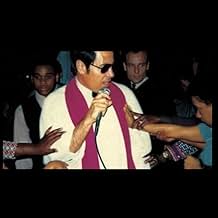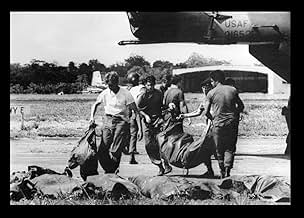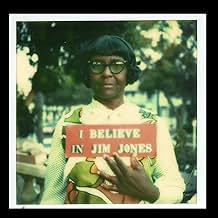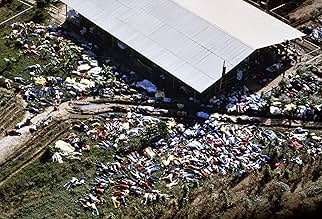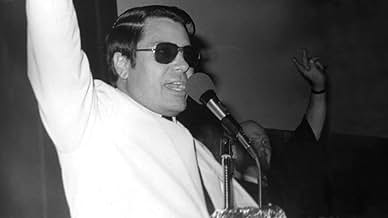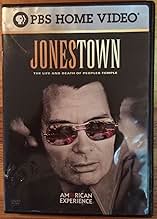Jonestown - Todeswahn einer Sekte
- 2006
- 1 Std. 26 Min.
Füge eine Handlung in deiner Sprache hinzuFeaturing never-before-seen footage, this documentary delivers a startling new look at the Peoples Temple, headed by preacher Jim Jones who, in 1978, led more than 900 members to Guyana, whe... Alles lesenFeaturing never-before-seen footage, this documentary delivers a startling new look at the Peoples Temple, headed by preacher Jim Jones who, in 1978, led more than 900 members to Guyana, where he orchestrated a mass suicide via tainted punch.Featuring never-before-seen footage, this documentary delivers a startling new look at the Peoples Temple, headed by preacher Jim Jones who, in 1978, led more than 900 members to Guyana, where he orchestrated a mass suicide via tainted punch.
- Auszeichnungen
- 1 Gewinn & 4 Nominierungen insgesamt
- Self
- (as Rev. Garnett Day)
Empfohlene Bewertungen
There are many challenges and traps associated with telling this story and mostly this film works because it avoids the majority of them and deals well with the telling. The first challenge is to get the viewer to a point where it is at least understandable how Jones could lead such a movement to such an extent. One of the contributors says that nobody sets out to join a cult that will hurt them but yet the film makes it reasonably clear why so many people ultimately did and why so many people put up with so much out-and-out weirdness and oppression. In doing this the material naturally suggests that Jones is a monster or crazy and it would have been easy to ham this aspect up with music etc to the detriment of the film. As it works out, the film doesn't do this and instead lets events speak for themselves without really pulling cheap tricks to sensationalise or demonise anyone unnecessarily.
As a result it all comes over even handed and fair. The heavy use of those directly involved makes it a lot more interesting than a heavy narrator-led approach because you hear things first hand and have an insiders perception of events. Some viewers will feel the lack of conspiracy in the film but I did not because the film was on the general sweep of the tragedy rather than suggested stories behind it. OK so the material does a lot of the work by having a lot of inherent interest within it but even still this documentary is effectively structured with a good personal presentation that gets inside the world of the People's Temple and Jonestown.
The whole People's Temple story always struck me as just another of the 60's cult phenomena. We had Rajneesh and his farm, and uncountable other guru's who exploited, and continue to exploit, large numbers of gullible followers. The Moonies are still with us, but well below the radar most of the time.
What's odd about Jim Jones -- to me, anyway -- is that no one really seems to know who this guy really was. This film gives more insight than anything else I've seen or read. It talks about his childhood, which was extremely poor, and his family situation, which was equally grim, so we get some insight there. But he was a very carefully guarded fellow. Always wearing those shades, always talking in the manner of a preacher. But who was he really? What was he like when he took off the robes and had a beer? We may never know. His followers certainly didn't know, and no doubt that's a major part of the problem. There is one scene in this documentary in which Jones is standing at the back of a group of people at a large gathering, and his demeanor reminded me of the dictator in North Korea -- it was that kind of vague, arrogant, totally in control look. Spooky.
The most telling comment in this film was the remark made by one of the PT's former members, who said "No one ever goes and joins a cult. They join a church, or a club." But what is the tipping point at which people can tolerate psychological and physical abuse against themselves and their friends? We don't get an answer to that. The people who made this film didn't have to tell us the answer, but it would have been a better film if they had.
Untrained in the ministry, he nonetheless started his own church in Indiana - an offshoot of the Christian Church (Disciples of Christ) - while still in his early 20s, later, in 1965, moving it west to a rural commune-like setting in Ukiah, in Northern California, when he was 34, where he also renamed the church People's Temple Full Gospel Church.
After 9 years, in 1974 he moved the church again, this time to San Francisco, where he ingratiated himself with local politicos like George Moscone and Willie Brown, and, in return for his support of Moscone for Mayor, Jones was appointed to the city's housing commission. By 1977 Jones had the itch to move again, and this time his church bought a large tract of land in the interior of Guyana, in northwestern South America. There a settlement, Jonestown, was rapidly established to permanently house over 1,000 church members. In November, 1978, after receiving complaints that all was not well in Jonestown, that people were being forcibly separated from loved ones back home and more or less held hostage, a California Congressman, Leo Ryan, made a trip to Jonestown to see for himself what was going on.
Ryan never returned, for he was shot and killed on the aircraft runway at Jonestown by armed stooges of Jones's, on orders to do so because Jones feared that Ryan would bring trouble if allowed to return to the States. Later that same day, November 18, 1978, Jones used his extensive PA system to order all of his supplicants to take a cyanide drink, to escape the misery that would befall Jonestown once authorities came in large numbers, to go on over to the other side, i.e., presumably to Heaven, where they would find peace.
911 church members died that day, many infants and children given poison by their parents, who then also took the poison drink to create possibly the largest mass suicide in history. Some who did not take poison were, like Rep. Ryan, shot to death. This was also the apparent cause of death for Jones himself. Another 80 members were away on some sort of field trip and were spared.
This is the fifth and perhaps most unusual of director Stanley Nelson's documentaries, which always concern race and the African-American condition (his prior feature films have taken up black press journalists; Marcus Garvey; Oaks Bluff, a black summer community on Martha's Vineyard; and the musical group Sweet Honey in the Rock).
Nelson's interest in Jonestown is connected with the fact that a majority of Jones's supplicants were black. Jones pandered to the suffering of poor blacks and whites alike. He also had sex with many women in the church, and even offered to sodomize anyone - female or male - who asked for or wanted this kind of connection to him, and apparently many did.
Nelson's approach here is intensely personal. He intercuts archival footage - of Jones's life, his activities and various stages in the development of his church - with contemporary interviews of persons who lost loved ones in Guyana. There are no talking heads: no sociologists, no academics who study religious cults, not a single mental health professional to educate us here. Nelson doesn't want us to understand the root causes of this tragedy; he wants us to feel the pain, the grief that this horrible and senseless loss of life wrought, just to feed the craving for power that was obviously Jones's main source of sustenance. It is an agonizing story to witness. My grades: 7/10, B (Seen on 11/25/06)
However I did find the repeat use of some archival footage a bit weak, and unless I missed it, it was never explained that the "Planning Commission" was part of the Peoples Temple itself.
Like any good documentary, it left me wanting to find out more, but I did think that it was an omission not to attempt any consideration of what led Jones to turn what had been a beneficial organisation, into a murderous one. Neither does the film attempt to look into how the organisation was run - presumably Jones couldn't have directly controlled the 1,000 inhabitants of Jonestown? The source of the poison and weapons is also a subject that doesn't feature, or the question of what happened to the money afterwards?
Overall this is a really interesting film, especially for those of us who were too young to remember the events.
Wusstest du schon
- WissenswertesBased on the same real life events as Jonestown Cult Suicide (2012), Jonestown Massacre: As We Watched (2018), Jonestown - Massenselbstmord einer Sekte (2018), Jonestown (2013), Jonestown: Paradise Lost (2007), Jonestown: The Women Behind the Massacre (2018), Guyana-Massaker - Tor zur Hölle (1980), The Jonestown Haunting (2020), Jonestown: The Life and Death of the Peoples Temple (2007), The Jonestown Massacre (2016) and Truth and Lies: Jonestown, Paradise Lost (2018).
- Zitate
Deborah Layton: [on Jim Jones's brainwashing of his followers at Jonestown] Every night at some point, his voice would come over the loudspeaker, and he'd say, "I'm sending somebody out tonight. Somebody you know. Somebody you trust. And they're gonna act like they wanna leave. But this is a loyalty test, and you need to turn them in."
- SoundtracksWelcome
Performed by the People's Temple Choir
Top-Auswahl
- How long is Jonestown: The Life and Death of Peoples Temple?Powered by Alexa
Details
- Erscheinungsdatum
- Herkunftsland
- Offizieller Standort
- Sprache
- Auch bekannt als
- Jonestown: The Life and Death of Peoples Temple
- Produktionsfirma
- Weitere beteiligte Unternehmen bei IMDbPro anzeigen
Box Office
- Bruttoertrag in den USA und Kanada
- 148.292 $
- Eröffnungswochenende in den USA und in Kanada
- 7.482 $
- 22. Okt. 2006
- Weltweiter Bruttoertrag
- 148.292 $
Zu dieser Seite beitragen





